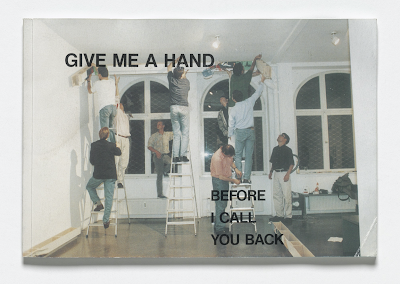Dan Graham
Rock My Religion
Cambridge, USA: MIT Press, 1993
330 pp., 20 x 27.5 cm., hardcover
Edition size unknown
Sharing its title with Graham's celebrated 1984 film (scored by Glenn Branca and Sonic Youth), this volume collects eighteen essays written by the late artist between 1965 and 1990. These include articles rejected by magazines such as Artforum, Arts, Esquire, ZG and Screen, and published by Aspen Magazine, Vito Acconci and Bernadette Mayer's 0 - 9, Open Letter (Toronto), Real Life (New York), Parachute (Montreal), Art Press (Paris), and (eventually) Artforum.
The volume is divided into three sections: "Information: Conceptual Art/Magazines/The Sixties", "Performance: Punk Rock, Popular Culture, Theater" and "Architecture: Art/Design/Urbanism". Each alternates between descriptions and documentation of Graham's own projects with his writings about other artists (Carl Andre, Dan Flavin, Donald Judd, Gordon Matta-Clark, Bruce Nauman) and musicians (The Ramones, Devo, Patti Smith, The Sex Pistols, The Runaways, Lydia Lunch, The Slits).
The title essay traces the parallels not only between religion and rock music, but between rock music and propaganda, rock music and capitalism, politics, the media, etc. etc.
Flipping through it today - for the first time in years - I'm most enjoying a text about Sex Pistols manager Malcolm McLaren. It recounts the story of the band Adam and the Ants asking the impresario to help "reshape their image". McLaren began by ousting Adam as the lead singer, replacing him with fourteen year-old Annabella Lwin (and briefly, also, George Alan O'Dowd, who would later achieve superstardom as Boy George). Changing the band's name to Bow Wow Wow, he wrote the controversial lyrics to their songs which ranged from the innuendo-laden "Sexy Eiffel Tower" (complete with faux-orgasmic panting by the adolescent singer) and songs promoting cassette piracy (released on the largest record label at the time).
The book includes Graham's influential interventions in newspapers and magazines, such as
Detumesecence (1969) and
Figurative (1965), important texts such as
Homes for America (1966-67), performative works like
Performer/Audience/Mirror (1977) and early forays into public art, including
Children's Pavilion (1989), a collaboration with Jeff Wall.
Wall also provides a blurb for the dust jacket:
"Dan Graham's essays are essential reading for everyone interested in the big issues in art and culture since the 60s - and some of the little issues too."
as does Kim Gordon:
"Dan was the first person to encourage me to write. By participating in performance of his involving an all-girl band he also encouraged me to play music. Sonic Youth would never have existed without Dan Graham. Rock My Religion is a fresh momento of Dan's perceptive brilliant and friendship".
Rock My Religion spans twenty-five years of Graham's work, which would continue for another thirty-two, until his death on Saturday at the age of 79.
























































